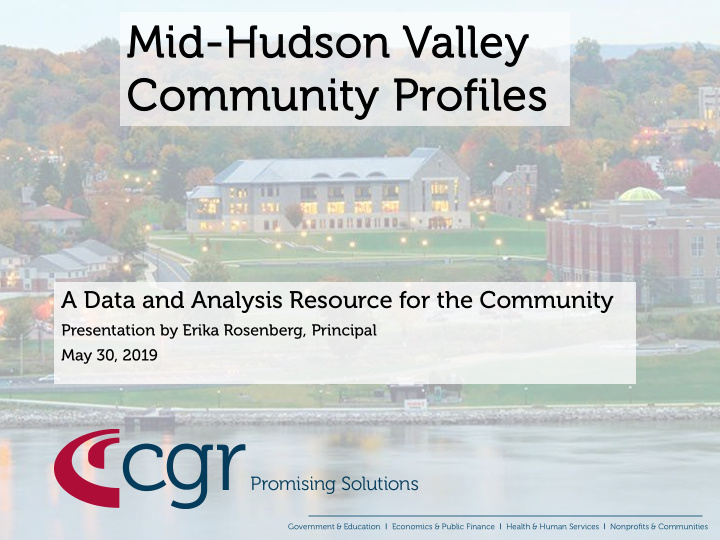



Mid Mid-Hu Huds dson Valley y Com ommunit nity Profiles ofiles A Data and Analysis Resource for the Community Presentation by Erika Rosenberg, Principal May 30, 2019 Government & Education I Economics & Public Finance I Health & Human Services I Nonprofits & Communities
About the Project • Designed to provide government and nonprofits with an important tool for assessing and understanding the populations they serve • Continuously updated, comparative information • CGR provided data, analysis and website development • CGR is nonprofit research and consulting organization headquartered in Rochester, NY and founded in 1915 by Eastman Kodak founder George Eastman 2
MHV Community Profiles – What’s in it • 59 indicators across 9 topics • Columbia, Dutchess, Greene, Orange, Putnam, Sullivan, and Ulster counties • NYS and US, wherever available • Local data for towns, villages and cities 3
Key Components • For each indicator • Data visualization(s) • Text analysis • Downloadable data tables (rate and raw) • Key Trends analysis for each topic, combined into an Overview PDF • Resources – related data and information 4
What’s New • Data for Columbia, Greene, Putnam and Sullivan counties • Maps for select indicators • New indicators • Drug-related deaths • Living wage • Foreign-born residents • Income by poverty level (<50%, 50-99%, 100-199%, 200-299%, >300%) 5
Let’s have a look… www.MHVCommunityProfiles.org 6
Trends • The Mid-Hudson Valley continues to be a relatively strong region of New York State • Increasing population • Higher job growth • Rising home values • Challenges include: • Unaffordable housing • New challenges, such as the rise of drug-related deaths connected to the opioid epidemic • Making ends meet, which can be difficult for a broad swath of the population 7
Demographics Population Change, 2000-17 16% 12% 10% 6% 6% 4% 2% 2% 1% -1% -4% Source: U.S. Census Bureau 8
Demographics • Population over 60 growing, while under 40 has shrunk • Since 2000, 85+ grew most, up 49% • Counties becoming more diverse but remain mostly white at 80% • Hispanics fastest growing, up 86% from 2000 • Asian population second fastest growing group, up 74% • Share that is foreign born increased since 2000 • Putnam County had the largest share (13%) followed by Dutchess and Orange (both 11%) 9
Economy • Jobs grew 13% from 2001-17 in the region, below the nation (18%) but above the state (10%) • Inflation-adjusted spending by county government grew 14% from 2000-17, compared to 3% statewide • Regional level was $2,200 in 2017, compared to $2,400 for the state • Tourism revenue increased 11% since 2005 • Tourism brought about $2,200 per capita into the region in 2017, above state level of $2,100 • Strongest in Sullivan and Greene counties on a per-capita basis 10
Economy Change in Jobs by Sector, 2000-17 Total 14% Trade, Transportation, Utilities 7% Professional/Business Services 33% Other Services 24% Manufacturing -37% Leisure/Hospitality 34% Health Care/Social Assistance 34% Government -3% Financial Activities 42% Educational Services 49% Construction -7% Source: U.S. Bureau of Economic Analysis 11
Financial Stability • Poverty is relatively low at 11% for the region • But 28% of residents had incomes 100%-299% of the poverty level • Living wage models estimate two working parents with two children need to earn $86,000 a year, more than three times the poverty level (about $25,000) for a family of this type • A single earner with two children to support needs an even higher wage, $79,000 a year, to make a living wage 12
Financial Stability • Median incomes higher than state and nation but not keeping up with inflation • Incomes declined 4% 2000 to 2013-17 to $70,150 • Racial/ethnic disparities: Asian and white: $100,400 and $73,000; African American and Hispanic: $52,500 and $58,500 • Mirrored in poverty: Asian and white: 8%, 10%; African American and Hispanic: 20%, 17% • About 7% of seniors and 5% of veterans were living in poverty in 2013-17 13
Financial Stability • Help for struggling individuals and families • 1.5% of children participated in subsidized child care in 2017 • 14% of tax filers in the region received the Earned Income Tax Credit (EITC) in 2016, on par with the state and below the nation (18%) 14
Housing Affordability Ratio for Homeowners Ratio of home value to income 4.5 4.0 Columbia 3.5 Dutchess 3.0 Greene 2.5 Orange 2.0 Putnam 1.5 Sullivan 1.0 Ulster 0.5 Region 0.0 2000 2008-12 2013-17 Source: U.S. Census Bureau 15
Children & Youth Prekindergarten Participation 45% 40% Columbia 35% Dutchess 30% Greene Orange 25% Putnam 20% Sullivan 15% Ulster 10% Region 5% NYS 0% 2007 2017 Source: NYS Education Department 16
Health Drug Overdose Mortality Rate, per 100,000 Residents 20 18 16 14 12 10 8 6 4 2 0 2007 2008 2009 2010 2011 2012 2013 2014 2015 2016 Region NYS U.S. Greene Sullivan Source: Centers for Disease Control and Prevention 17
Public Safety Violent Crime Rate, per 10,000 Residents 195 Source: FBI, NYS Division of 175 Criminal Justice Services 155 135 115 95 75 55 35 15 2008 2009 2010 2011 2012 2013 2014 2015 2016 2017 Region NYS U.S. Poughkeepsie Newburgh Monticello 18
Community Engagement • Average charitable giving is below the state and nation at $3,600 in 2016 • That was up 16% from 2011, below the increases at the state and national levels of 25% and 28% • Voter registration has remained steady at above 80%, a bit lower than the state • 82% were registered in 2017, compared to 84% for the state • Voter turnout approaches 60% in presidential election years, about even with the state 19
Q and A • Questions? • Contact Information: CGR Erika Rosenberg, Principal erosenberg@cgr.org (585) 327-7066 20
Recommend
More recommend